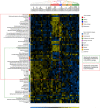Global metabolomic profiling of uterine leiomyomas
- PMID: 29073636
- PMCID: PMC5729474
- DOI: 10.1038/bjc.2017.361
Global metabolomic profiling of uterine leiomyomas
Abstract
Background: Uterine leiomyomas can be classified into molecularly distinct subtypes according to their genetic triggers: MED12 mutations, HMGA2 upregulation, or inactivation of FH. The aim of this study was to identify metabolites and metabolic pathways that are dysregulated in different subtypes of leiomyomas.
Methods: We performed global metabolomic profiling of 25 uterine leiomyomas and 17 corresponding myometrium specimens using liquid chromatography-tandem mass spectroscopy.
Results: A total of 641 metabolites were detected. All leiomyomas displayed reduced homocarnosine and haeme metabolite levels. We identified a clearly distinct metabolomic profile for leiomyomas of the FH subtype, characterised by metabolic alterations in the tricarboxylic acid cycle and pentose phosphate pathways, and increased levels of multiple lipids and amino acids. Several metabolites were uniquely elevated in leiomyomas of the FH subtype, including N6-succinyladenosine and argininosuccinate, serving as potential biomarkers for FH deficiency. In contrast, leiomyomas of the MED12 subtype displayed reduced levels of vitamin A, multiple membrane lipids and amino acids, and dysregulation of vitamin C metabolism, a finding which was also compatible with gene expression data.
Conclusions: The study reveals the metabolomic heterogeneity of leiomyomas and provides the requisite framework for strategies designed to target metabolic alterations promoting the growth of these prevalent tumours.
Conflict of interest statement
The authors declare no conflict of interest.
Figures




References
-
- Adam J, Hatipoglu E, O'Flaherty L, Ternette N, Sahgal N, Lockstone H, Baban D, Nye E, Stamp GW, Wolhuter K, Stevens M, Fischer R, Carmeliet P, Maxwell PH, Pugh CW, Frizzell N, Soga T, Kessler BM, El-Bahrawy M, Ratcliffe PJ, Pollard PJ (2011) Renal cyst formation in Fh1-deficient mice is independent of the Hif/Phd pathway: roles for fumarate in KEAP1 succination and Nrf2 signaling. Cancer Cell 20: 524–537. - PMC - PubMed
-
- Adam J, Yang M, Bauerschmidt C, Kitagawa M, O’Flaherty L, Maheswaran P, Özkan G, Sahgal N, Baban D, Kato K, Saito K, Iino K, Igarashi K, Stratford M, Pugh C, Tennant DA, Ludwig C, Davies B, Ratcliffe PJ, El-Bahrawy M, Ashrafian H, Soga T, Pollard PJ (2013) A role for cytosolic fumarate hydratase in urea cycle metabolism and renal neoplasia. Cell Rep 3: 1440–1448. - PMC - PubMed
-
- Allegri G, Fernandes MJ, Scalco FB, Correia P, Simoni RE, Llerena JC Jr, de Oliveira ML (2010) Fumaric aciduria: an overview and the first Brazilian case report. J Inherit Metab Dis 33: 411–419. - PubMed
-
- Baird DD, Dunson DB, Hill MC, Cousins D, Schectman JM (2003) High cumulative incidence of uterine leiomyoma in black and white women: ultrasound evidence. Am J Obstet Gynecol 188: 100–107. - PubMed
-
- Benjamini Y, Hochberg Y (1995) Controlling the false discovery rate: a practical and powerful approach to multiple testing. J R Stat Soc Series B Stat Methodol 57: 289–300.
MeSH terms
Substances
Grants and funding
LinkOut - more resources
Full Text Sources
Other Literature Sources
Medical
Miscellaneous

